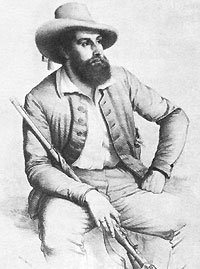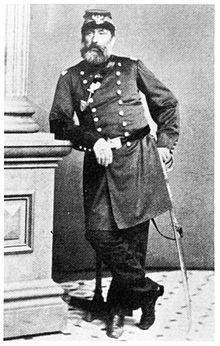Germain Metternich

Germain Franz Metternich (5 April 1811
Early years
Germain Metternich was born in 1811 in Mayence, the capital of the French Département du
Activities during the German Revolution 1848/1849
The first uprisings of the German Revolution reached Mainz in spring 1848. A vigilance committee was formed very quickly under the command of Franz Heinrich Zitz, a local lawyer. Metternich was elected as his adjutant. At the same time, Metternich was also in charge of a paramilitary, partially armed unit of politically active gymnasts ("Turner"). In late April 1848, Metternich joined the Mainz chapter of the "Communist League“. This was an early organisation of the labour movement headquartered in Brussels, which was where Karl Marx was living at that time. When the "Demokratische Verein“ was founded on 11 May 1848, Metternich also joined this association. At the first of two conventions for democratic politicians, held in the Free City of Frankfurt in June 1848, he was elected, along with others such as Franz Heinrich Zitz, to serve on the provisional central committee of the Radical Democrat faction.
When in May 1848 insurrections versus the Prussian troops in Rheinhessen were mobilised, Metternich was on the side of the vigilance committee. In a combat in the palace garden of Kirchheimbolanden, the revolutionary were defeated and Metternich fled together with other leading revolutionaries like Ludwig Bamberger, Louis Blenker, and Franz Zitz abroad. After his participation in the September uprising of 17 and 18 September in Frankfurt was unveiled, authorities wished to apprehend him, so he had to get into hiding again. He appeared on a "Signalement“ (wanted poster), published in the newspaper Schleswig-Holsteinische Anzeigen on 2 October 1848. There Metternich was described as follows: Signalement: 1) Germain Metternich from Mainz: age about 25 years, height very huge, hair golden blond, eyes blue, eyebrows blond, nose bended, mouth well-proportioned, forehead high, beard golden blond and awesome, chin covered over, teeth sound, face oval, clouring healthful, constitution type athletic and slim.[3] He returned to Germany during the Constitution Campaigns of 1849 and participated actively in the Palatinate-Baden uprising. There he fought amongst others together with Franz Sigel. After the abolition he fled to Switzerland again. In Mainz he was charged with a "High treason” lawsuit in the following year. Metternich was acquitted, but expelled from Germany. When Switzerland also expelled him shortly afterwards, he emigrated to the USA.
Life in the United States

When Metternich emigrated to the United States in 1850 he settled in New York. Metternich was engaged with the set up of a political active Turnerschaft. Under his decisive influence the "Socialistischer Turnverein von New-York“.
When the
Literature
- Richard Falck: Germain Metternich: ein deutscher Freiheitskämpfer, der letzte Staatsgefangene der Marksburg; Eine Lebensbeschreibung. Auslieferung: H. Krichtel, Mainz 1954.
- Walter Hell: Der Radikaldemokrat Germain Metternich und die freisinnigen Rheingauer. in: Walter Hell: Vom Mainzer Rad zum Hessischen Löwen. Sutton Verlag Erfurt, 2008. ISBN 978-3-86680-356-5.
- Anton Maria Keim: Germain Metternich – vom Mainzer Revolutionär zum amerikanischen Turner-General. in: Lebendiges Rheinland-Pfalz. Zeitschrift für Kultur und Geschichte. Ausgabe 13, 1976, S. 86–88.
Notes
- ^ Regarding birthday and -year sources with different readings exist. 10 April is noted as his birthday as well, and his year of birth sometimes also appears as 1804. An entry in a parish register, retrievable via familysearch.org using search criterion "Germain Metternich“, documents the baptism of a "Germannus Franciscus Metternich“ on 6 April 1811 in Mainz Cathedral, leading to the conclusion that 5 April 1811 as birthday and -year seems most plausible.
References
- ^ The Sun, Baltimore, Maryland, 20 May 1862: Lieut. Col. Germain Metternich, of the Forty-sixth New York Volunteers, was killed at Tybee.
- ^ Jörg Schweigard: Politische Turnvereine in Deutschland 1817–1840. in: H. Reinalter (Hrsg.): Politische Vereine, Gesellschaften und Parteien in Zentraleuropa 1815-1848/49. Frankfurt am Main 2005, S. 51–77.
- ^ Schleswig-Holsteinischen Anzeigen 1848
- ^ Ansgar Reis: Radikalismus und Exil: Gustav Struve und die Demokratie in Deutschland und Amerika. S. 268
- ^ 46th Regiment, New York Volunteers
External links
- demokratiegeschichte.eu – Germain Metternich (1811–1862)
